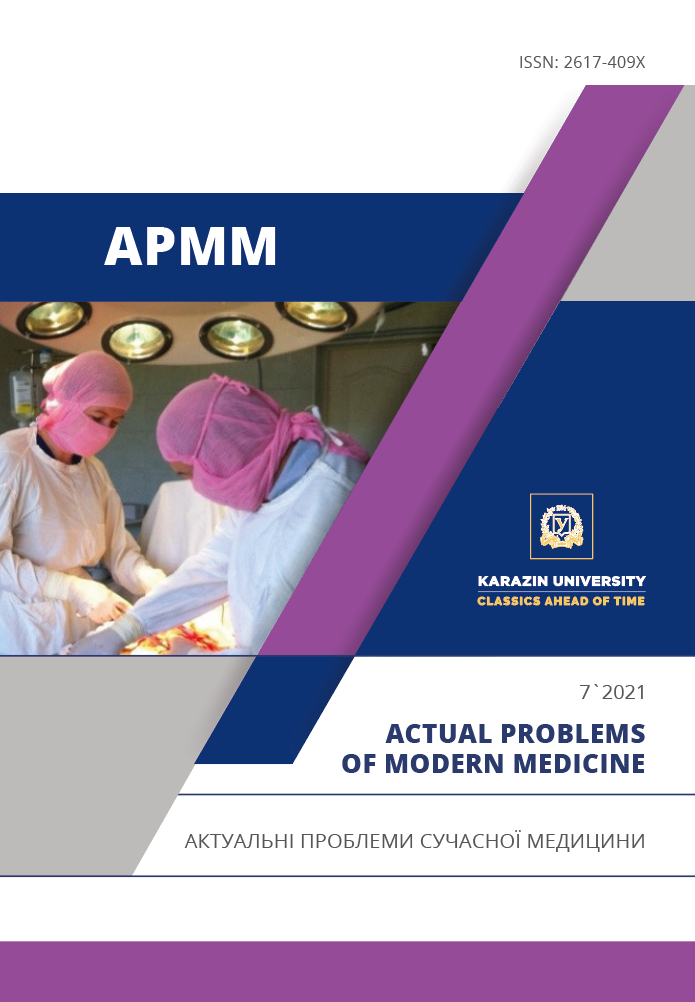The morphological specifics of the stromal and parenchymal liver components of 6-12-months old children from hiv-mono-infected mothers
Abstract
To determine the morphological specifics of the stromal and parenchymal liver components of 6-12-months old children from HIV-mono-infected mothers. Materials and methods. The morphometric investigation included 87 liver tissue biopsies of 6-12-months old dead children from HIV-mono-infected mothers. All morphometric parameters of the parenchymal and stromal liver components were calculated using the Avtandilov`s microscopic morphometric grid, which was consisted of 100 equidistant points. It was inserted into the microscope`s ocular tube with a total × 200 microscope magnification. The number of points that were found on the corresponding types of parenchymal and stromal liver components was calculated. In every case, it was selected 10 random microscopic areas and then all data were obtained, calculated and presented as percentages. Results. Morphometric parameters of hepatocytes: mononuclear hepatocytes – 90.2±7.6 % [control – 93.5±7.1], two-nuclear hepatocytes – 9.8±1.2 % [control – 6.5±1.2], TMHC (two-/mononuclear hepatocytes coefficient) – 0.10±0.02 [control – 0.06±0.01], hepatocytes with fat vacuoles – 19.6±2.1 % [control – 0.5±0.2]. Parenchymal and stromal liver components: parenchyma – 56.1±3.3 % [control – 74.2±4.3], stroma (including blood vessels and bile ducts) – 43.9±3.7 % [control – 25.8±2.6], SPI (stroma/parenchyma index) – 0.78±0.02 [control – 0.34±0.01]. Morphometric parameters of all of the liver components: hepatocytes – 56.1±3.3 % [control – 74.2±4.3], portal tracts – 26.4±2.1 % [control – 3.1±0.6], central veins – 8.1±1.2 % [control – 9.3±1.4], sinusoids – 7.3±1.2 % [control – 10.5±1.3], bile ducts – 2.1±0.1 % [control – 2.9±0.2]. Expression level parameters: fibronectin – 73.2±4.2 % [control – 17.3±2.5], collagen type I – 15.9±1.2 % [control – 9.7±1.9], collagen type III – 20.1±2.6 % [control – 10.1±0.9], collagen type IV – 7.3±0.2 % [control – 5.9±0.2]. Conclusions. It was established, that in the liver of 6-12-months old children from HIV-mono-infected mothers, the parenchymal component of the liver showed the signs of its significant reduction, increase of regenerative activity of hepatocytes, and fatty degeneration of hepatocytes with a certain sign of reactive steatohepatitis. Also, it was established, that the stromal component of the liver of children from HIV-infected mothers showed the signs of its progressive proliferation and collagenization due to increased production and accumulation of fibronectin, type I, type III collagens in the stroma of portal tracts and newly formed septa, and the signs of hepatic sinusoid capillarization due to type IV collagen accumulation in the space of Disse of the hepatic sinusoids.
Downloads
References
UNAIDS. Joint United Nations. Programme on HIV/AIDS. Geneva. 2018. 370 р. https://www.unaids.org.ua/ua/hiv-epidemic-in-ukraine/epidemiologichna-situatsiya#1.
Stover J et al. What Is Required to End the AIDS Epidemic as a Public Health Threat by 2030? The Cost and Impact of the Fast-Track Approach // PLOS ONE / ed. Lima V.D. Public Library of Science (PLoS). 2016;11(5):e0154893. DOI: https://doi.org/10.1371/journal.pone.0154893.
Ravichandra KR. Opportunistic infections in HIV infected children and its correlation with CD4 count. International Journal of Contemporary Pediatrics. 2017;4(5):1743-1747. DOI: http://dx.doi.org/10.18203/2349-3291.ijcp20173777.
Penton PK, Blackard JT. Analysis of HIV Quasispecies Suggests Compartmentalization in the Liver. AIDS Research and Human Retroviruses. Mary Ann Liebert Inc. 2014;30(4):394-402. https://doi.org/10.1089/AID.2013.0146.
Joshi D et al. Increasing burden of liver disease in patients with HIV infection // The Lancet. Elsevier BV. 2011. Vol. 377, № 9772. P. 1198–1209. https://doi.org/10.1016/S0140-6736(10)62001-6.
Avtandilov GG. The basics of quantitative pathological Anatomy. Moscow: 2002. 240 p.
Sterling RK, Smith PG, Brunt EM. Hepatic Steatosis in Human Immunodeficiency Virus. Journal of Clinical Gastroenterology. Ovid Technologies (Wolters Kluwer Health). 2013;47(2):182–187. https://doi.org/10.1097/MCG.0b013e318264181d.
Bongiovanni M, Tordato F. Steatohepatitis in HIV-Infected Subjects: Pathogenesis, Clinical Impact and Implications in Clinical Management. Current HIV Research. 2007;5:490–498. https://doi.org/10.2174/157016207781662407.
Hynes RO. The Extracellular Matrix: Not Just Pretty Fibrils. Science. American Association for the Advancement of Science (AAAS). 2009;326(5957):1216–1219. https://doi.org/10.1126/science.1176009.
Bataller R, Brenner DA. Liver fibrosis/ Journal of Clinical Investigation. 2005;115(2):209–218. https://doi.org/10.1172/JCI24282.
Hernandez-Gea V, Friedman SL. Pathogenesis of Liver Fibrosis. Annual Review of Pathology: Mechanisms of Disease. Annual Reviews. 2011;6(1):425–456. https://doi.org/10.1146/annurev-pathol-011110-130246.
Campana L, Iredale J. Matrix Metalloproteinases and Their Inhibitors. Stellate Cells in Health and Disease. Elsevier. 2015. P. 107–124. https://doi.org/10.101 157.
Marra F, Caligiuri A. Cytokine Production and Signaling in Stellate Cells. Stellate Cells in Health and Disease. Elsevier. 2015. P. 63–86. https://doi.org/10.1016/B978-0-12-800134-9.00005-16/B978-0-12-800134-9.00007-5.
Mastroianni C. et al. Molecular Mechanisms of Liver Fibrosis in HIV/HCV Coinfection. International Journal of Molecular Sciences. MDPI AG. 2014;15(6): 9184–9208. https://doi.org/10.3390/ijms15069184.
Gupta D et al. HIV-1 Infected Peripheral Blood Mononuclear Cells Modulate the Fibrogenic Activity of Hepatic Stellate Cells through Secreted TGF-β and JNK Signaling. PLoS ONE ed. Kaushik-Basu N. Public Library of Science (PLoS). 2014;9(3):e91569. https://doi.org/10.1371/journal.pone.0091569.




